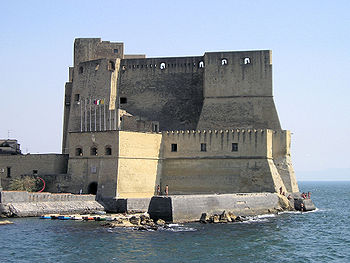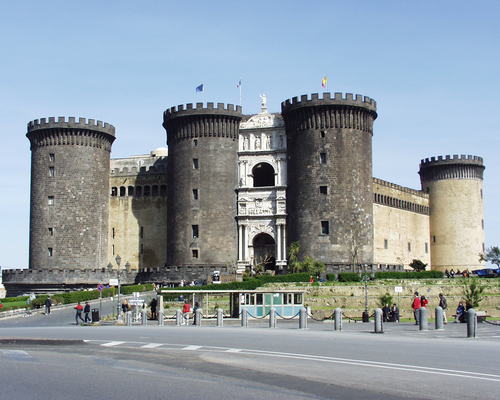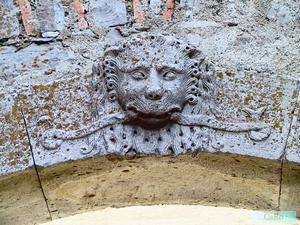|
Regional History Part 2 1275 to 1700 A.D. by Thomas Frascella
Installment 1 In some way it could be said that the seed for the immigration to and the establishment of European colonies in the Americas began in 1275. In that year three northern Italians by the name of Polo arrived at the court of the great Mongol Emperor of China. They would remain there in the service of the Khan for seventeen years before returning to Europe. The travel journal that would eventually be authored by Marco Polo would ignite the imagination of Europe for generations and open the possibility of direct access to Asia in the minds of merchants and explorers for centuries. Southern Italy and Sicily at this time found themselves under the oppressive Angevin regime which was closely tied to the French crown. The Popes also closely aligned to the French vacated Rome in favor of a more politically secure Avignon, France. Although San Fele had just barely avoided extermination other parts of the south were very much at risk. The Angevin Charles I set his capital in Naples not Palermo. Sicily after centuries of prosperity from trade and crusader traffic was now subjected to systematic looting, taxes and worst by some 5,000 Angiven troops garrisoned on the island. In addition, Islamic Saracens which Frederick II had relocated from Sicily to northern Lucania at Lucera fiercely maintained their independence from the Angiven regime. Lucera became the gathering point of all of the remaining Islamic faithful in Italy and their numbers grew in Lucera to about 50,000. The Sicilians found the conditions to which they were subjected intolerable. Many had been Hohenstaufen loyalist and with the male line of the Hohenstaufen’s purged they turned to Peter III of Spanish Aragon for support. Peter as previously stated had married Constance the oldest daughter of Manfred Hohenstaufen. The Sicilians offered Peter Kingship of Sicily in return for his military support against the Angivins. The situation was complicated by the fact that if Peter supported the Sicilians in revolt he could be attacked by Charles I older brother the King of France. Eventually Peter agreed to provide naval support but retained his army in Spain leaving the Sicilians to deal with the garrisons on the island on their own. On Easter Monday April 30, 1282 at the hour of Vespers the Sicilians revolted. The revolt is known as the War of the Sicilian Vespers and lasted depending on the version you read between six days and six weeks. It was a war without a major battle in which the revolting side fielded no army, identified no generals and exposed no clear and identifiable command structure. Nevertheless in a matter of days not a single Angivin soldier was left alive and none escaped on the island of Sicily. In 1283 naval forces of Peter managed to capture the oldest son and heir apparent of Charles I in a naval battle in the bay of Naples. In 1284 Charles I died with his oldest son still captive in the hands of Peter’s forces. In a truce brokered by Edward “ Longshanks” King of England southern Italy was divided with Peter installed as King of Sicily and Charles’ son now known as Charles II as King of Naples. So began essentially six hundred years of Spanish rule over Sicily. I should note that the marriage of Peter and Constance was a productive one and that many of their descendants can be found in the great noble and royal houses of Europe. Today, both King Juan Carlos of Spain and Queen Elizabeth of England are among their direct descendants. As tensions subsided between the Angivin and Aragonese factions tensions grew between the Angivins and the Saracens of Lucera. A bloody war broke out ending in the defeat and destruction of the Saracen forces in 1301. Those who were not killed in the war were given a choice of conversion to Christianity or exile from Italy. Most Saracens choose exile, leaving Italy and settling in what today would be Albania. On Friday October 13, 1307 Templar knights were rounded up and Templar property confiscated in an operation directed by King Phillip of France and supported by the Angevins. Although initially the Angivins tried to retain the Templar properties in southern Italy eventually they were forced to cede the properties to the Church. Charles II was succeeded by his son Robert I who sadly outlived his own son leaving a female heir Joanna who in 1334 was only six years old. Robert I probably concerned that a Queen especially a young Queen would not be strong enough to rule arranged in 1334 for Joanna to be betrothed to her five year old cousin the second son of the King of Hungary. In 1343 Robert I died and in his Will declared that Prince Andrew upon his marriage to Joanna would reign as King, not as co-regent. The young couple wed in 1344 and took up residence in the main Angevin palace, a fortress known as Castle Nuovo in Naples. Joanna apparently was not resigned to the arrangement of settling in as Queen to Andrew as King as set up by her grandfather Robert I. The young marriage got off to a very difficult beginning. Throughout this period the European foothold in the near east and holy land continued to erode. However, trade continued to flow through Sicily and southern Italy. Unfortunately, with the trade in the late 1340’s arrived the Bubonic Plague or Black Death as it was also known. Modern medical experts believe that rather than being an isolated event mutating strains of the plague disease flared up across Europe every generation or so from the mid 1300’s until the early 1700’s. We tend to focus on the first two outbreaks of the 1340’s and 1370’s because they were the most severe in terms of death rate. The Plague actually first entered Europe from the near east through Sicily and the ancient trade routes including the Appian Way in the 1340’s. It is estimated that between 1347 and 1352 the Plague reduced the population of Europe by twenty-five percent. First signs of infection were usually a ringed rash or swelling with the victim experiencing a painful fervor laden death between five and seven days later. With one in four people dying of the disease and no understanding of the mechanism of the illness many people turned to the only comfort available, their faith. It is during this period, especially in southern Italy, that devotion to Mary as an interceder and nurturing “mother figure” becomes very strong. The image of the sitting Mary and infant Christ child as depicted in the Di Pierno statute becomes a very common image in the churches throughout the region and eventually throughout Europe. The depiction, so common in so many churches now, masks the fact the Di Pierno image is several hundred years older than other similar images of its type. While in San Fele the people refer to the statue and the image by its location in the hamlet of Pierno it is more common to refer to it by names such as Our Lady of Perpetual Help, Our Lady of Perpetual Care and Our Lady of Good Succor. All of these name references arise out of the Plague era. During the initial Plague outbreak the story of a young French nobleman on pilgrimage to Rome who stopped to minister to Plague victims in northern Italy also began to circulate. The many cures attributed to both his care and after his death his intercession also became a powerful devotional expression in the form of San Rocco. Every town in the Vulture either has a church or statute dedicated to San Rocco, including San Fele.
San Rocco
In 1347 Joanna appears to have decided to resolve her regency issues with Andrew by having her guards bind Andrew’s hands behind his back and with the royal silk bed sheet tied securely around his neck he was hung out the royal couple’s bedroom window. This act greatly upset Andrew’s older brother who had become King of Hungary and a state of war was entered between Hungary and the Kingdom of Naples. Joanna I reign extended until 1382 but was full of odd behaviors. She would eventually take a total of four husbands surviving all but the last. It is said she had scores of lovers who when they displeased her would be thrown to the crocodiles she kept in the lower level of Castle Nuovo for that purpose. Her general relationship with the Papacy which was headquartered in Avignon her hereditary province in France was shaky at best. At one point she converted her palace in Avignon which was located near the Papal palace into Europe’s largest brothel. Late in her reign a controversy over who should be Pope arose with two men both claiming the title Clement VIII and Urban. Joanna and her cousin the King of France supported Clement, basically most of the rest of Europe supported Urban. After Clement died, Pope Urban moved the papacy back to Rome. He then became part of an alliance which supported removing Joanna in favor of her nephew Charles of Durazzo. Charles with the aide of
troops sent by Hungary was able to defeat Joanna’s army commanded by
her fourth husband. Charles lay siege to Joanna’s fortress Castle
Nuovo but before it fell Joanna escaped to a second fortress called
Castle Dell’Ovo also in Naples. However she was finally forced to
surrender there. While her fate was being decided by Charles and his
allies Joanna was imprisoned at the fortress at Muro Lucano a town
which neighbors San Fele. It was determined that she should be
executed by strangulation at the hands of executioners sent by the
King of Hungary.
Castle Dell’Ovo
Castle Nuovo
Shortly before the time appointed for her execution there was raised a concern that she might escape. In order to insure that no escape occurred it was decided to transfer her to the fortress at San Fele. On May 12, 1382 Joanna was strangled with a silken chord within the fortress atop Monte Castello in San Fele.
Stone crest attached to Pallazzo Frascella San Fele
On a more contemporary note, more can be learned on the subject of Joanna I by reading the short story written by Alexandre Dumas in 1839 called “Joan of Naples” although he makes the common error of reporting that she was executed in Muro Lucano. Also during the repairs to the abbey which now attaches to the Church in Pierno a crypt was discovered below the abbey floor. The repairs were being made as a result of damage caused by the earthquake that struck the region in 1980. The crypt which restorers date to the Angivin period does not identify its long since missing occupant. However, as the crypt predates the abbey by several hundred years its location is odd. Usually the burial of wealthy or important persons would either be in the Church itself or in a cemetery which was blessed. This crypt is outside the church and not among other burials. I believe the speculation is that this is Joanna’s final resting place.
© San Felese Society of New Jersey
|



